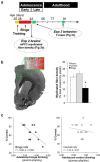Alcohol binge drinking during adolescence or dependence during adulthood reduces prefrontal myelin in male rats
- PMID: 25355229
- PMCID: PMC4212071
- DOI: 10.1523/JNEUROSCI.3189-13.2014
Alcohol binge drinking during adolescence or dependence during adulthood reduces prefrontal myelin in male rats
Abstract
Teen binge drinking is associated with low frontal white matter integrity and increased risk of alcoholism in adulthood. This neuropathology may result from alcohol exposure or reflect a pre-existing condition in people prone to addiction. Here we used rodent models with documented clinical relevance to adolescent binge drinking and alcoholism in humans to test whether alcohol damages myelinated axons of the prefrontal cortex. In Experiment 1, outbred male Wistar rats self-administered sweetened alcohol or sweetened water intermittently for 2 weeks during early adolescence. In adulthood, drinking behavior was tested under nondependent conditions or after dependence induced by 1 month of alcohol vapor intoxication/withdrawal cycles, and prefrontal myelin was examined 1 month into abstinence. Adolescent binge drinking or adult dependence induction reduced the size of the anterior branches of the corpus callosum, i.e., forceps minor (CCFM), and this neuropathology correlated with higher relapse-like drinking in adulthood. Degraded myelin basic protein in the gray matter medial to the CCFM of binge rats indicated myelin was damaged on axons in the mPFC. In follow-up studies we found that binge drinking reduced myelin density in the mPFC in adolescent rats (Experiment 2) and heavier drinking predicted worse performance on the T-maze working memory task in adulthood (Experiment 3). These findings establish a causal role of voluntary alcohol on myelin and give insight into specific prefrontal axons that are both sensitive to alcohol and could contribute to the behavioral and cognitive impairments associated with early onset drinking and alcoholism.
Keywords: adolescent; alcohol; binge; dependence; myelin; prefrontal.
Copyright © 2014 the authors 0270-6474/14/3414777-06$15.00/0.
Figures



Similar articles
-
Region-specific interneuron demyelination and heightened anxiety-like behavior induced by adolescent binge alcohol treatment.Acta Neuropathol Commun. 2019 Nov 8;7(1):173. doi: 10.1186/s40478-019-0829-9. Acta Neuropathol Commun. 2019. PMID: 31703603 Free PMC article.
-
Alcohol drinking during early adolescence activates microglial cells and increases frontolimbic Interleukin-1 beta and Toll-like receptor 4 gene expression, with heightened sensitivity in male rats compared to females.Neuropharmacology. 2021 Oct 1;197:108698. doi: 10.1016/j.neuropharm.2021.108698. Epub 2021 Jul 9. Neuropharmacology. 2021. PMID: 34252404 Free PMC article.
-
Comparing behavior following binge ethanol in adolescent and adult DBA/2 J mice.Behav Brain Res. 2022 Feb 15;419:113703. doi: 10.1016/j.bbr.2021.113703. Epub 2021 Dec 3. Behav Brain Res. 2022. PMID: 34864163 Free PMC article.
-
Neurobiological Effects of Binge Drinking Help in Its Detection and Differential Diagnosis from Alcohol Dependence.Dis Markers. 2018 Jul 4;2018:5623683. doi: 10.1155/2018/5623683. eCollection 2018. Dis Markers. 2018. PMID: 30069273 Free PMC article. Review.
-
Neuroimmune activation and myelin changes in adolescent rats exposed to high-dose alcohol and associated cognitive dysfunction: a review with reference to human adolescent drinking.Alcohol Alcohol. 2014 Mar-Apr;49(2):187-92. doi: 10.1093/alcalc/agt164. Epub 2013 Nov 10. Alcohol Alcohol. 2014. PMID: 24217958 Review.
Cited by
-
Innate immune activation: Parallels in alcohol use disorder and Alzheimer's disease.Front Mol Neurosci. 2022 Sep 9;15:910298. doi: 10.3389/fnmol.2022.910298. eCollection 2022. Front Mol Neurosci. 2022. PMID: 36157070 Free PMC article. Review.
-
Effects of adolescent alcohol exposure on oligodendrocyte lineage cells and myelination in mice: Age and subregion differences.IBRO Neurosci Rep. 2024 Jun 19;17:220-234. doi: 10.1016/j.ibneur.2024.06.006. eCollection 2024 Dec. IBRO Neurosci Rep. 2024. PMID: 39282551 Free PMC article.
-
Binge-Like Alcohol Exposure During Adolescence Disrupts Dopaminergic Neurotransmission in the Adult Prelimbic Cortex.Neuropsychopharmacology. 2017 Apr;42(5):1024-1036. doi: 10.1038/npp.2016.190. Epub 2016 Sep 13. Neuropsychopharmacology. 2017. PMID: 27620551 Free PMC article.
-
Myelination of Axons Corresponds with Faster Transmission Speed in the Prefrontal Cortex of Developing Male Rats.eNeuro. 2018 Sep 13;5(4):ENEURO.0203-18.2018. doi: 10.1523/ENEURO.0203-18.2018. eCollection 2018 Jul-Aug. eNeuro. 2018. PMID: 30225359 Free PMC article.
-
Shortening time for access to alcohol drives up front-loading behavior, bringing consumption in male rats to the level of females.Biol Sex Differ. 2021 Sep 15;12(1):51. doi: 10.1186/s13293-021-00395-y. Biol Sex Differ. 2021. PMID: 34526108 Free PMC article.
References
Publication types
MeSH terms
Substances
Grants and funding
LinkOut - more resources
Full Text Sources
Other Literature Sources
Medical
